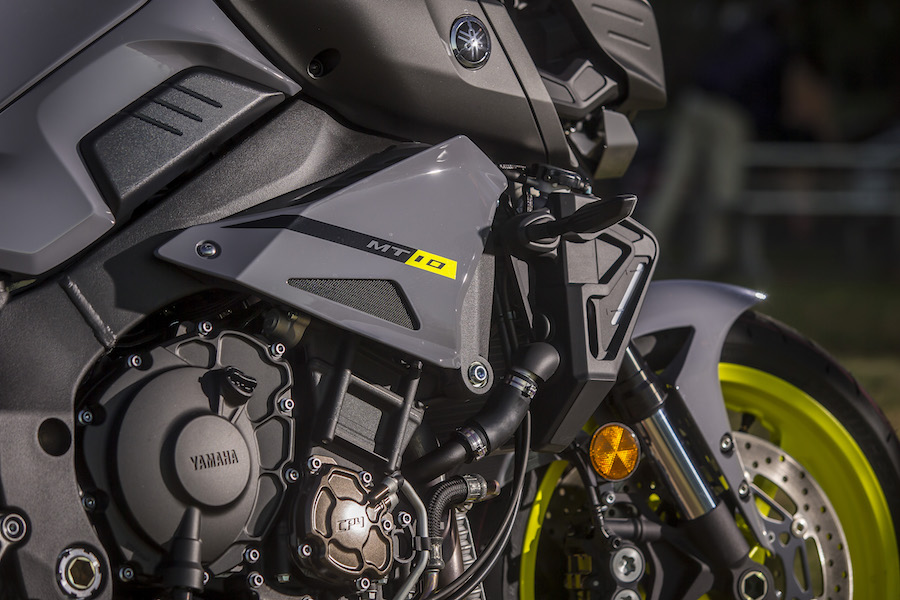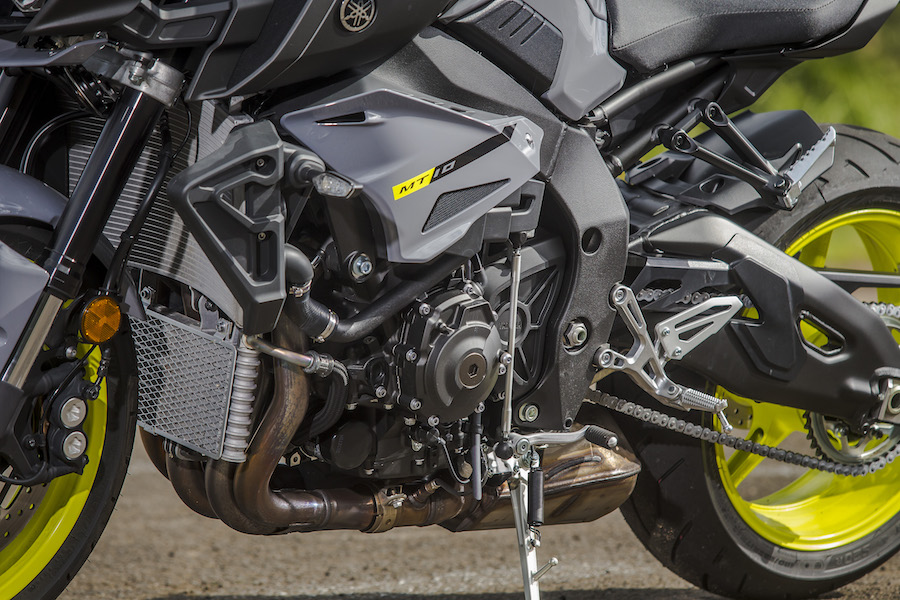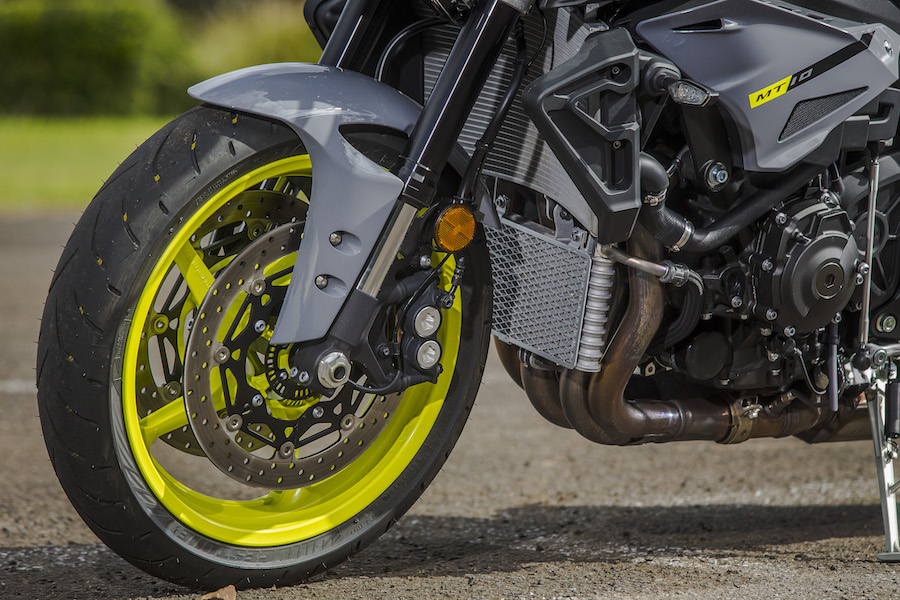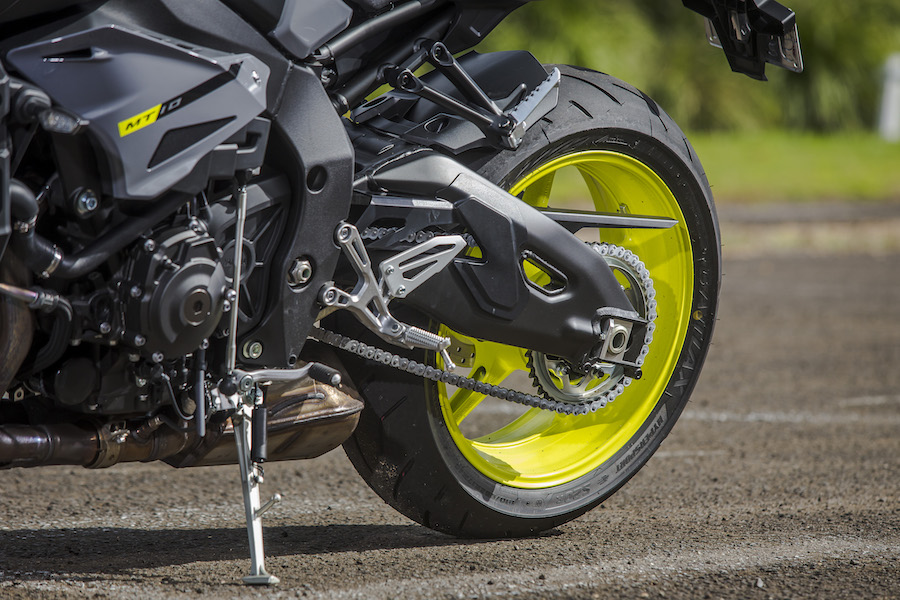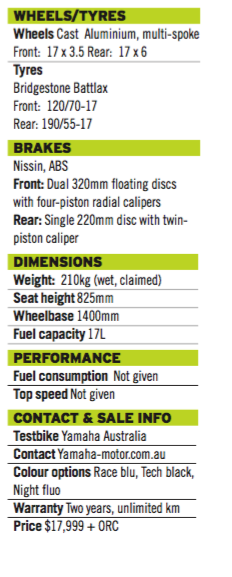It looks like a Transformer, pulls like a monster, and is the new top ranking bike in the MT army
In 2014 Yamaha pulled the covers off the MT-09 in what was arguably the launch of the MT (aka Monster Torque) range so far. Since then nearly every year, or even multiple times a year, the company has added to the MT line up to create one big family. From the moment a new rider swings a leg over a LAMS-approved MT model, Yamaha is attempting to build brand loyalty, with the ultimate goal of keeping the rider in the fold by offering model step-ups as their skill and desire increase throughout their riding life.
Until now the MT-09 was the top of the tree with its 847cc three-cylinder engine. And while it is a fantastic motorcycle in nearly all aspects, it just seemed to lack the credentials to lead the clan. The bloodline needed a big daddy – a true leader. With the release of the all-new MT-10, this leadership role has now been filled. Here is a model that can sit proudly atop the family tree and keep all other models in check.
Based on the latest generation YZF-R1, the MT-10 shares many of the same components as the superbike, but Yamaha insists it is more than just a naked R1 – it’s a fully fledged supernaked motorcycle. And to hold its own against the stiff competition in this segment, a simple superbike sans fairings will not cut it.
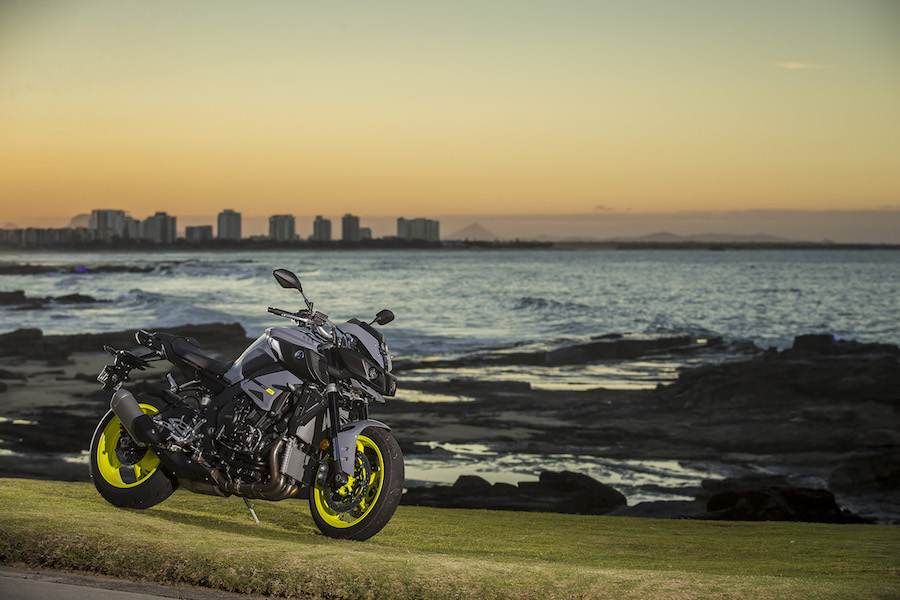
The Australian launch of the MT-10 was held on the beautiful Sunshine Coast, on the proposed sunshine coast TT circuit (see breakout) and gave us a day to put the MT-10 through its paces. This included tight corners, flowing country sweepers and even a jaunt through traffic to see if it lives up to its big daddy hype, and most importantly, if it really is an all-round everyday motorcycle – in other words, a liveable R1.
Powering the MT-10 is the same 998cc crossplane engine that can be found in the current R1. But the engineers haven’t just shoehorned that unit into the MT-10 chassis – they have also massaged its characteristics to trade peak power for greater torque. Rather than just resting on the laurels of the R1, Yamaha put a lot of development into the MT-10, and a massive amount of the engine has been re-designed.
The MT-10 powerhouse features a newly designed combustion chamber and intake port, compression has been dropped from 13.1 to 12.1, a heavier crankshaft has been fitted, and the camshaft has been re-designed, among other things. An oil-cooler has also been added to help with heat suppression in start-stop traffic – a more common scenario for the MT-10.
All these changes translate to an engine which producers a claimed 118kW at 11,500rpm. This may give around 30kW away to the R1 spec engine, but the real story is in its torque output. Maximum torque is nearly identical at 111Nm (112Nm for the R1), but it peaks some 2500rpm lower in the rev-range at 9000rpm. This gives the MT-10 a midrange surge that many other 1000cc four-cylinder engines can only dream of, and it transforms an already torquey superbike engine into a powerplant made for the road environment.
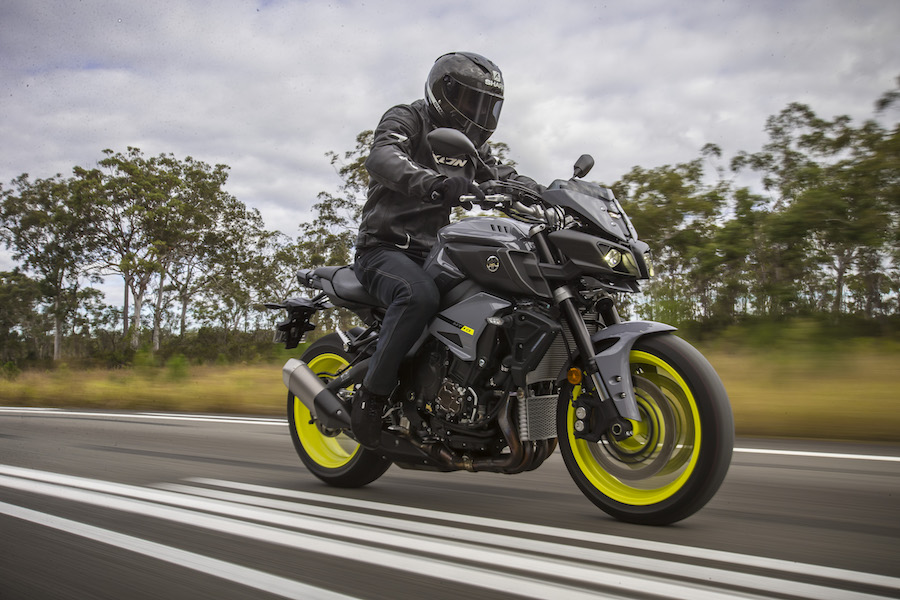
Twist the throttle and the engine pulls with potency from as low as 2000rpm before building into a postcode-changing midrange surge, while all the time keeping to a perfectly linear power curve. There are easily enough horses to loft the front wheel in the bottom three cogs, and ample torque to chug the MT-10 out of corners in a gear too high. The midrange power really lets you relish the engine at saner speeds instead of waiting for a high-end horsepower engine to spin up – which tends to happen at license-losing velocity.
For me, torque is what gets the adrenaline and excitement flowing on the road and the MT-10 has oodles of it as you punch from corner to corner. Coupled with the heavenly MotoGP-ish soundtrack that the big bang engine barks, all your inner senses are truly excited – the sound is that good.
Power is sent through a six-speed box that is silky smooth and direct, but due to the large spectrum of usable power, gear changes are kept to a minimum – in the twisties third and fourth are all you need. The clutch lever is light and offers a progressive feel throughout its actuation. A quickshifter is a $419 option, but ought to be standard. The slipper clutch kept the rear wheel chatter free, even under aggressive down changes.
As you’d expect from the current crop of supernaked bikes, the MT-10 is fitted with all the bells and whistles. It features three engine maps, traction control and ABS. Realising it could be used for touring, Yamaha has also fitted cruise control – good move.
The three engine maps are titled A mode, Standard mode and B mode and can be cycled on the fly through the right-hand switchblock. But beware, unlike all other Yamaha models B mode (not A) is the most aggressive – go figure. This was the map I used least, as throttle response is super direct and bordering on snatchy. ‘A’ mode was the pick of the bunch for me and offers a throttle response that is direct and accurate whether you’re cracking the throttle low in the rev-range or near the limiter. ‘Standard’ mode was the softest of the three.
The three-level traction control system was unobtrusive and did a great job of driving the MT-10 hard out of corners. The three levels can be cycled on the move, but deactivation can only happen at a standstill. One thing I loved about this system was the ability to pull power-wheelies with the system on – many other systems will bring the front wheel back down, some quite aggressively. And as the MT-10 has the habit of bringing out your inner hooligan this ability is a must if you’re a bit of a show pony. Just don’t flip it!
With a wheelbase of only 1400mm it is the shortest in the class and a full 35mm shorter than its nearest competitor (Kawasaki Z1000). And from the moment you swing your leg over the MT-10 it is obvious – it really does feel as if the front wheel is directly beneath you. The short wheelbase not only aids in doing wheelstands, but contributes to a super light and direct front end – you only have to breathe on the ’bars and the bike responds. Interestingly, at slow speeds such as though traffic the MT-10 steering is slightly heavy, but does lighten up as the clicks rise.
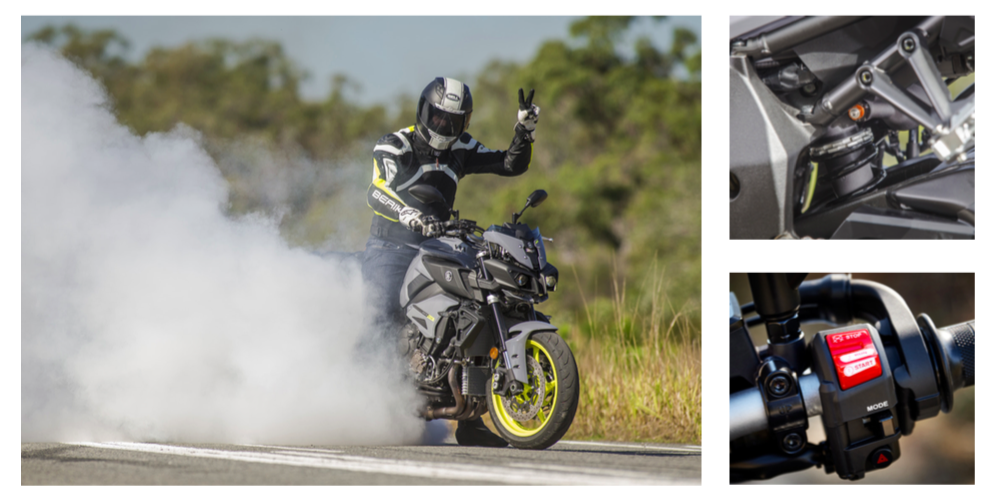
Yamaha hasn’t skimped on the suspenders, fitting the same fully adjustable KYB units that are found on the R1, though re-tuned for a softer ride. Tip-in is effortless, mid-corner stability is good, and the line doesn’t widen as you pile on the power. Bumps are dealt with better than the R1 and this in turn gives you more confidence to attack the road. Couple this with the more upright riding position, and I would hazard a guess that nearly all R1 riders would be quicker on an MT-10 through their favourite twisties – I know I would be. The electronic steering damper keeps the front in line under hard acceleration and even on crappy roads I didn’t suffer one headshake all test.
My 182cm frame found no irks in the riding position and the seat was quite plush, making the $395 comfort seat a luxury you can probably do without. The front does offer some wind protection, but the optional screen is a must for highway commutes. The cruise control is a welcomed addition and offers a resume function and speed adjustments – this is excellent, and much like heated handgrips, once you’ve tried it you won’t want to live without it. Speaking of heated handgrips they are a $293 option and in my opinion should be standard, but of course everything comes at a cost. There is also a 12V DC outlet as standard.
The dual 320mm four-piston front brakes offer good retardation, but aren’t of the same specification as the Euro bikes, which all sport Brembos, yet on the road they offer a softer initial bite and a more progressive feel. If someone claims they are running out of braking they should be racing. The 220mm single rear disc pinched by a two-piston caliper was super strong and really aided in slow speed manoeuvrability.

If you realise that corner is coming up a lot faster than expected, the MT-10’s ABS keeps everything in check. It pulsates quickly and allows you to ride the system deep into corners without the fear of a font-end washout. This system cannot be turned off.
At $17,999 (+ ORC) the MT-10 is at the lower end of the price spectrum for a supernaked motorcycle. It undercuts all the Euro machines with the closest being the BMW S1000R at $18,990 (+ ORC). It is more expensive than its Japanese counterparts with the Z1000 at $15,499 (+ ORC) and the Suzuki GSX-S1000 ride away at $16,490, but considering the most expensive nakeds such as the KTM Super Duke and Aprilia Tuono are all in the mid-twenties, it does offer some good bang for your buck.
The MT-10 is definitely worthy to lead the MT-clan, and if you are in the market for a supernaked you should make sure it is on your to-look-at list. There is something fun and exciting about the whole MT range and the 10 takes it to a whole new level. I promise you it is a fun family to be a part of.
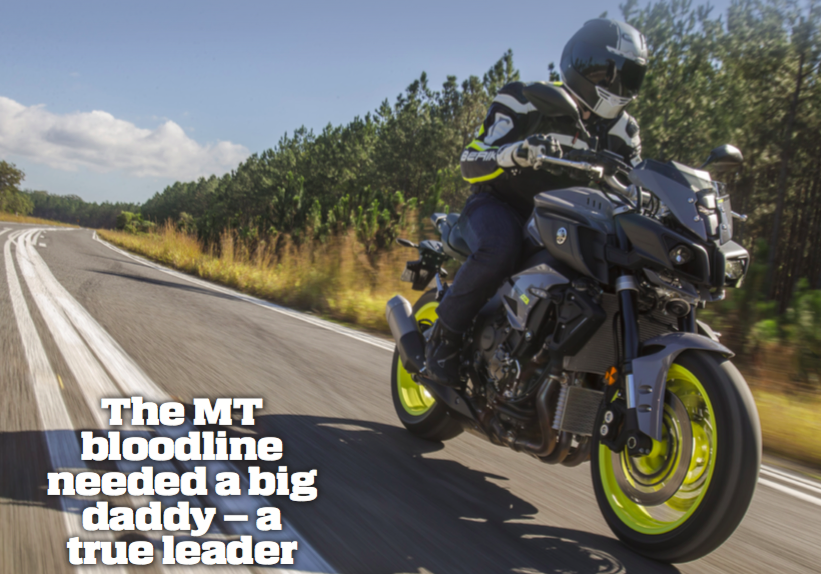
The competition
KTM Super Duke R
At 132kW and 144Nm it is the most powerful in its class – which is always a good thing for pub banter. It features fully adjustable WP suspension, Brembo monobloc calipers and all the electrickery you could want. It is more hard-core than the MT-10, and one of the more track-oriented in the class. At $23,500 + ORC it is the second most expensive with only the Aprilia Tuono Factory costing more.
Aprilia Tuono V4 Factory
It’s the most expensive in the class at $26,500 ride away, but is arguably the most kitted out one too. It features fully adjustable Öhlins bouncy bits and Brembo stoppers, and has the most advanced electronic package with traction control, ABS, quickshifter, wheelie control and even launch control. At 129kW it is the second most powerful and quite possibly the best sounding four-cylinder on the market. If the Factory is a bit rich, have a look at the base Tuono which loses some specs such as Öhlins, but importantly loses $3000.
Suzuki GSX-S1000
All you have to know is $16,490 ride away, and if anyone argues with that they are a bit loopy. While this is one of the cheapest in the class, by no means is it the most basic. It features a 107kW 1000cc engine, three-level traction control system, ABS and even Brembo anchors. The front utilises a fully adjustable KYB fork, while the rear makes use of a KYB monoshock that can be adjusted for preload and rebound.
Kawasaki Z1000
Unfortunately, the Z1000 is in a very fought over segment and in recent times has slid further down the ladder. At $15,499 (+ ORC) it is the cheapest in the class, but it is also the most basic. It doesn’t feature traction control, engine maps or any other electrickery, but the latest model does utilise ABS. The Z1000 engine is its saving grace – super smooth with an abundance of low down torque which, just like the MT-10, peaks at 111Nm. While the Z1000 seems to struggle on paper it does offer a fantastic experience where the rider rather than a computer is in control. The throttle is connected directly to the engine and traction control is your right wrist – there is something that makes that enjoyable.
BMW S1000R
At $18,990 (+ ORC) the Beemer is quite good value, especially when that includes basically the same electronic package that is fitted to the S1000RR – including the stability control. For $1250 you can add electronic suspension and heated grips, which still leaves it in the ‘good value’ bracket. Engine performance is basically identical to the MT-10 at 118kW and 112Nm.
Ducati Monster 1200 S
At $23,990 (+ ORC), this is about what you would expect to pay for a Euro supernaked with Öhlins and top of the range Brembos. The Monster gives a little away in the horsepower stakes with 106.6kW, but does produce an impressive 125Nm, which is only trumped by the Super Duke. Like all Euro machines it has a super-computer running it that includes traction control, ABS, and engine maps. It misses out on a quickshifter and cruise control, but gets the typical Ducati attention and is easily the loudest in the class. As with the Tuono there is a base Monster that costs $4000 less.
TEST ALEX PENKLIS PHOTOGRAPHY IKAPTURE
